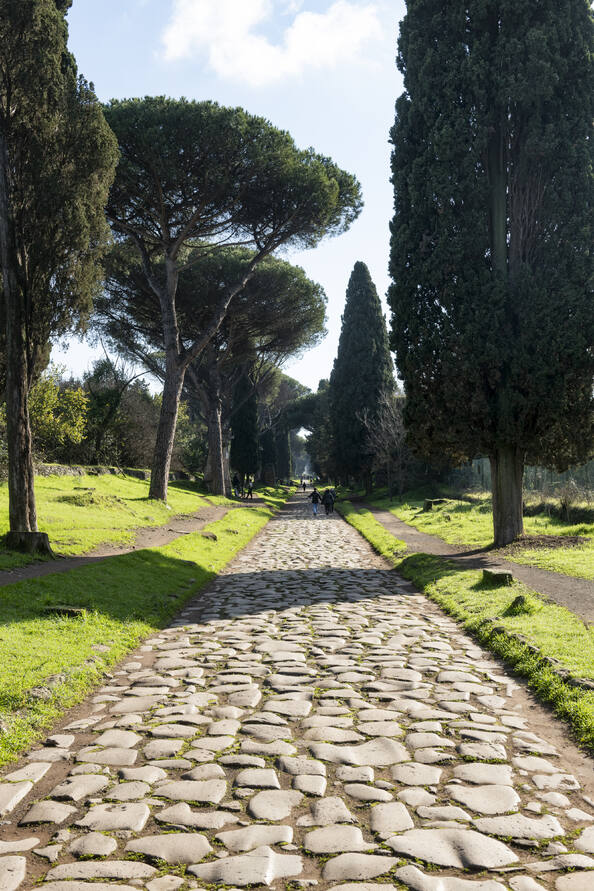مجمَّع الإقامة في شويرن
Via Appia. Regina Viarum
More than 800 kilometres long, the Via Appia is the oldest and most important of the great roads built by the Ancient Romans. Constructed and developed from 312 BCE to the 4th century CE, it was originally conceived as a strategic road for military conquest, advancing towards the East and Asia Minor. The Via Appia later enabled the cities it connected to grow and new settlements emerged, facilitating agricultural production and trade. This property, composed of 19 component parts, is a fully developed ensemble of engineering works, illustrating the advanced technical skill of Roman engineers in the construction of roads, civil engineering projects, infrastructure and sweeping land reclamation works, as well as a vast series of monumental structures including, for example, triumphal arches, baths, amphitheatres and basilicas, aqueducts, canals, bridges, and public fountains.
Description is available under license CC-BY-SA IGO 3.0
Via Appia. Regina Viarum
Longue de plus de 800 kilomètres, la Via Appia est la plus ancienne et la plus importante des grandes voies romaines. Construite et aménagée de 312 avant notre ère au IVe siècle de notre ère, elle a été conçue à l’origine comme une voie stratégique de conquête militaire vers l’Orient et l’Asie Mineure. La Via Appia a ensuite permis aux villes qu’elle reliait de se développer avec l’apparition de nouveaux établissements, facilitant l’agriculture et le commerce. Ce bien composé de 19 éléments constitutifs constitue un ensemble complet d’équipements et d’ouvrages d’art illustrant la grande technicité de l’ingénierie romaine dans la réalisation de voies, de travaux de génie civil, d’assainissement et de développement, ainsi qu’un vaste ensemble d’ouvrages monumentaux tels des arcs de triomphe, des thermes, des amphithéâtres, des basiliques, des aqueducs, des canaux, des ponts et des fontaines publiques.
Description is available under license CC-BY-SA IGO 3.0
مجمَّع الإقامة في شويرن
أُنشئ معظم هذا المجمَّع في القرن التاسع عشر فيما كان يُعرف حينها بعاصمة دوقية مكلنبرغ-شويرن في شمال شرق ألمانيا، ويتألف الموقع من 38 عنصراً، بما فيها قصر إقامة الدوق الأكبر ومنازل النبلاء والمباني المخصصة للأغراض الثقافية والدينية وبحيرة بفايفنتايش الاصطناعية التزيينية. ويلبي هذا المجمَّع أيضاً جميع الوظائف المطلوبة من عاصمة للدوقية من ناحية الإدارة والدفاع والبنية الأساسية للخدمات والنقل والمكانة الاجتماعية والأنشطة الثقافية، إلى جانب الحدائق والقنوات والبرك والبحيرات والأماكن العامة. وتشكِّل هذه المباني مجمَّعاً معمارياً استثنائياً يعكس الروح التاريخية لذلك الوقت التي تتنوع بين النهضة الجديدة والباروك الجديد والكلاسيكية الجديدة مع تأثيرات للنهضة الإيطالية.
source: UNESCO/CPE
Description is available under license CC-BY-SA IGO 3.0
阿庇亚道:道路女王
阿庇亚道(Via Appia)全长800多公里,是古罗马人修筑的最古老、最重要的大道。工程始于公元前312年,最初目的是作为军事征服的战略要道,向东方和小亚细亚延伸。直至公元4世纪,它不断得到完善和扩展。后来,阿庇亚道的存在使其连接的城市不断发展壮大,新的居住区涌现,从而促进了农业生产和贸易。该遗产包含19个部分,组成完整的工程建筑群,展现了罗马工程师在道路建设、土木工程项目、基础设施、大规模土地开垦方面的高超技术,以及在建造凯旋门、浴场、圆形剧场和大教堂、渡槽、运河、桥梁、公共喷泉等大型建筑上的精湛技艺。
source: UNESCO/CPE
Description is available under license CC-BY-SA IGO 3.0
Аппиева дорога. Реджина Виарум
Аппиева дорога длиной более 800 километров — самая древняя и значимая из великих дорог, построенных древними римлянами. Она была построена в 312 году до н. э. и развивалась с IV века н. э. Изначально она задумывалась как стратегическая дорога для военных завоеваний для продвижения на Восток и в Малую Азию. Позднее города, которые соединяла Аппиева дорога, стали разрастаться, появились новые поселения, что способствовало развитию сельского хозяйства и торговли. Объект состоит из 19 составных частей и представляет собой комплекс инженерных работ, иллюстрирующий передовое техническое мастерство римских инженеров в области строительства дорог, объектов гражданской инфраструктуры и мелиоративных работ. В объект также входит множество монументальных сооружений, включая, например, триумфальные арки, бани, амфитеатры и базилики, акведуки, каналы, мосты и фонтаны.
source: UNESCO/CPE
Description is available under license CC-BY-SA IGO 3.0
Via Appia. Regina Viarum
La Via Appia, con una extensión de más de 800 kilómetros, es la más antigua y la más importante de las grandes vías romanas. La Via Appia, construida y acondicionada desde el 312 a. e. c. hasta el siglo IV a. e. c., fue concebida originalmente como una vía estratégica de conquista militar hacia Oriente y Asia Menor. Posteriormente, la Via Appia permitió el desarrollo de las ciudades que conectaba y el surgimiento de nuevos asentamientos, facilitando así la producción agrícola y el comercio. Este bien, que está compuesto por 19 partes, es un conjunto de obras de ingeniería plenamente desarrollado que ilustra las habilidades técnicas avanzadas que poseían los ingenieros romanos para la construcción de calzadas, los proyectos de ingeniería civil, las infraestructuras y las amplias obras de saneamiento; pero también una gran variedad de estructuras monumentales como arcos triunfales, baños, anfiteatros y basílicas, acueductos, canales, puentes y fuentes públicas.cas.
source: UNESCO/CPE
Description is available under license CC-BY-SA IGO 3.0
